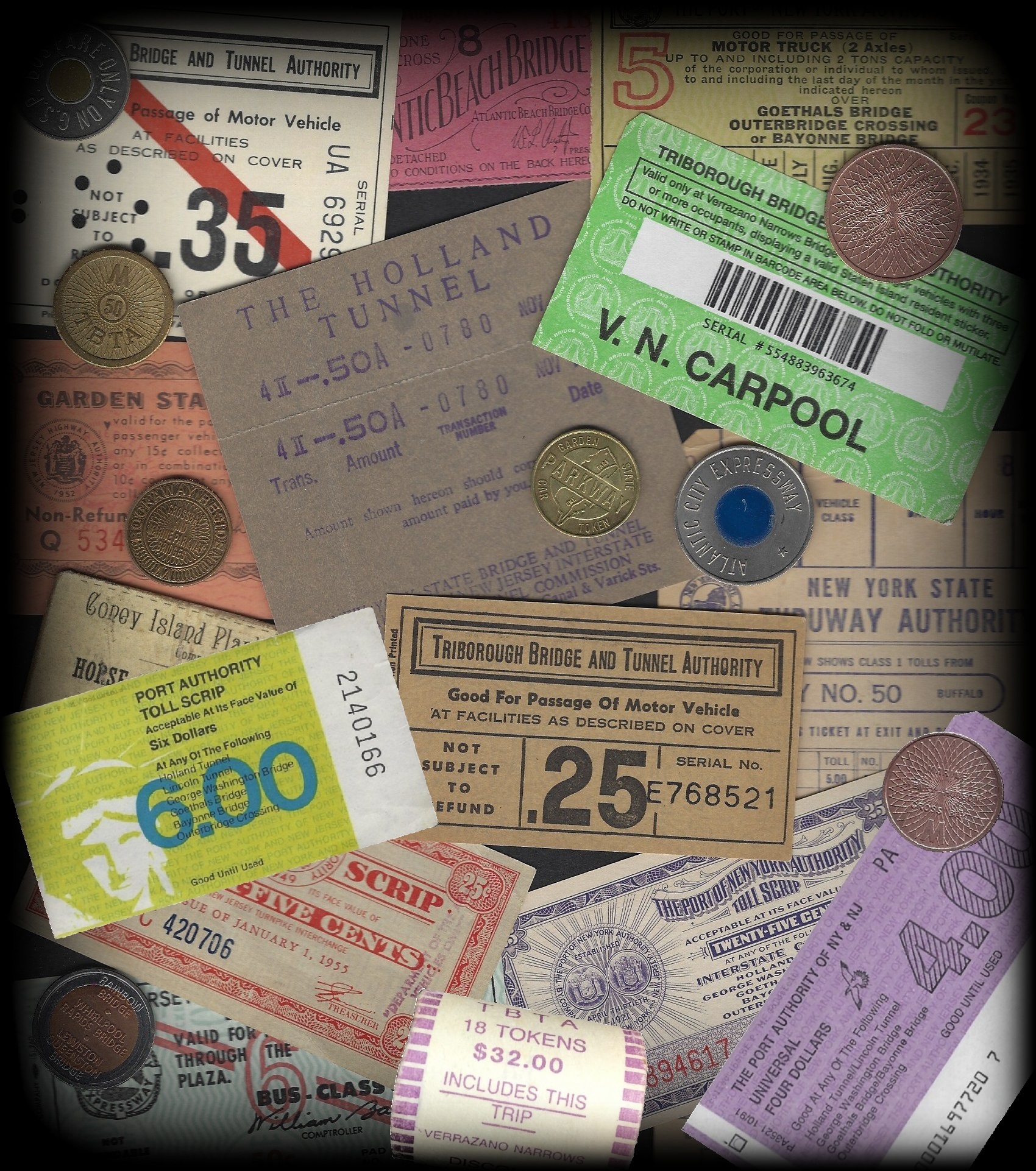 |
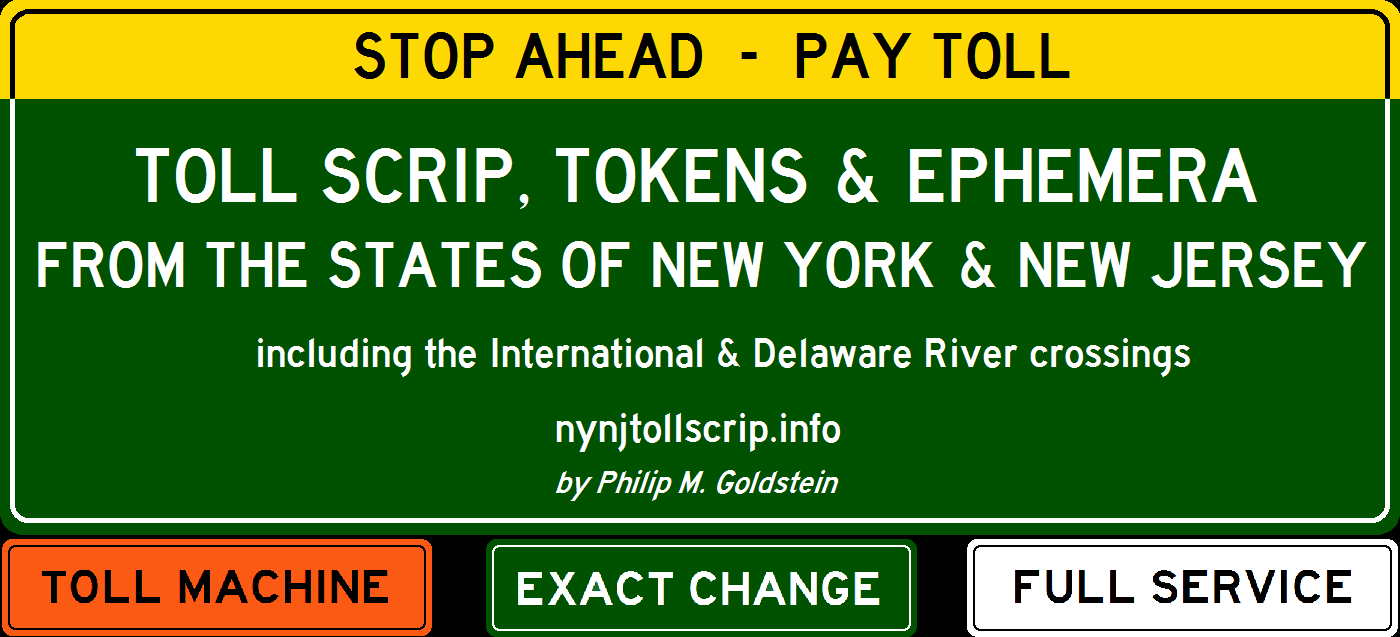 |
| . | ||||||||||||||||||||||||||||||||||||||||||||||||||||||||||||||||||||||||||||||||||||||||||||||||||||||||||||||||||||||||||||||||||||||||||||||||||||||||||||||||||||||||||||||||||||||||||||||||||||||||||||||||||||||||||||||||||||||||||||||
| You are on Page 1 | Page 2 | Page 3 | Page 4 | Page 5 | Page 6 | Page 7 | Page 8 | |||||||||||||||||||||||||||||||||||||||||||||||||||||||||||||||||||||||||||||||||||||||||||||||||||||||||||||||||||||||||||||||||||||||||||||||||||||||||||||||||||||||||||||||||||||||||||||||||||||||||||||||||||||||||||||||||||||||
| City of New York | City of New York | City of New York | States of NY & NJ | State
of New York |
State of New Jersey | State of New Jersey | ||||||||||||||||||||||||||||||||||||||||||||||||||||||||||||||||||||||||||||||||||||||||||||||||||||||||||||||||||||||||||||||||||||||||||||||||||||||||||||||||||||||||||||||||||||||||||||||||||||||||||||||||||||||||||||||||||||||||
Private and Early Toll Bridges, Plank Roads & Turnpikes |
Pre-TBTA Agencies: Triborough Bridge Authority Henry Hudson Parkway Authority Marine Parkway Authority New York City Tunnel Authority |
Triborough Bridge & Tunnel Authority MTA Bridges & Tunnels |
New York State Bridge and Tunnel Commission / New Jersey Interstate Bridge and Tunnel Commission Port of New York Authority Port Authority of New York and New Jersey |
Private & Early Toll Bridges, Plank Roads & Turnpikes NYS Thruway NYS Bridge Authority International Crossings |
New Jersey Turnpike Garden State Parkway Atlantic City Expressway |
Private Bridges County Operated Bridges Delaware River Crossings |
||||||||||||||||||||||||||||||||||||||||||||||||||||||||||||||||||||||||||||||||||||||||||||||||||||||||||||||||||||||||||||||||||||||||||||||||||||||||||||||||||||||||||||||||||||||||||||||||||||||||||||||||||||||||||||||||||||||||
| updated: 1/22/2024 |
2/18/2024 |
6/20/2024 |
7/23/2025 |
7/2/2025 |
1/5/2025 |
10/27/2025 |
11/2/2024 | |||||||||||||||||||||||||||||||||||||||||||||||||||||||||||||||||||||||||||||||||||||||||||||||||||||||||||||||||||||||||||||||||||||||||||||||||||||||||||||||||||||||||||||||||||||||||||||||||||||||||||||||||||||||||||||||||||||||
| . | ||||||||||||||||||||||||||||||||||||||||||||||||||||||||||||||||||||||||||||||||||||||||||||||||||||||||||||||||||||||||||||||||||||||||||||||||||||||||||||||||||||||||||||||||||||||||||||||||||||||||||||||||||||||||||||||||||||||||||||||
Hello & welcome! You have found the most extensive compendium of
information regarding Toll Scrip & Token Issues from the States
of New
York
and New Jersey.
Please note, this website pertains to the tolls charged on those bridges, tunnels and highways and the methods used to pay and collect said tolls. As with most obscure ephemera & exonumia issues, in-depth details regarding the toll scrip and token issues of the New York / New Jersey Metropolitan area, were severely lacking. While collectors including myself for years have known of and acquired these token & scrip issues; short of club or convention presentations, not much was publicly known nor has documentation has been forthcoming to recording their history to posterity. To this collectors best knowledge and research, this is the first online website regarding these issues, and it was borne out of research. Credit and the impetus for this website belongs to Paul Strubeck, my co-author on our railroad topic websites. He inquired of me:"trying to find NYC bridge toll rates, from 1988." To better explain, he was researching an obscure truck trailer rail bogie operation on the Long Island Rail Road; and needed to know what a tractor trailer would be charged to cross from the New Jersey, and into New York. After not finding the answer online, and as he remembered that I collected toll scrip and tokens, led to his directing his inquiry to me. I did not have a straightforward answer, as such a tractor trailer trip would involve two different agencies, and a several different possible routes. This began the quest to compile the historic toll rates throughout the decades for all classes of vehicles, not just automobiles. And so, here we are. Tokens:
For those token issues that are known, I use the widely recognized and respectable Atwood Coffee Catalog for United States & Canadian Transportation Tokens, Seventh Edition (2016), Volume One. I have encountered token varieties that are not listed. So, I took the liberty to expand upon the Atwood Coffee numbering system with a subletter. In regards to "modern" era New York / New Jersey Metropolitan Area toll fiscal issues, there are two separate and distinct agencies that issued fiscal items for toll use; the Triborough Bridge & Tunnel Authority or "TBTA", which has become the Metropolitan Transportation Authority - Bridges & Tunnels and the Port Authority of New York and New Jersey "PANYNJ", which was formerly known as Port of New York Authority. Because each of these agencies issued such a broad scope of toll scrip and / or tokens, there are covered on their own respective pages. Over the decades, so many books and websites have been published on the tunnels and bridges of New York and New Jersey (as well as other locations), and by so many authors; that "gephyrofans" have a huge selection to choose from, whether from the internet or brick and mortar bookstores. But literally nothing in the way of the history of the tolls, tickets, tokens and scrip for these crossings. Scrip / Tickets / Coupons:
To my knowledge, there are no catalogs, guides or other reference materials. While the above transportation token issues have been cataloged over the decades, courtesy of the Atwood Coffee catalog and the American Vecturist Association (vecturist: a collector of transportation tokens). Toll scrip on the other hand has remained relatively unknown. Scrip is sort of like the introverted child, playing by itself in a corner of a room somewhere while its popular sibling, the token; is surrounded by lots of friends and attention. As in much of my observations, paper money collectors have always has a smaller population than that of coin collectors. Here is where this website should set the bar for research, reference and cataloging and it here I hope this website corrects this regarding these paper issues. Navigating This Website
In the first year of this websites existence, it had been asked of me "why don't I split up this one big page" into smaller pages for each topic. Like with my railroad related websites; while doing such would certainly make my life a tad easier and organized from the beginning, it would be harder for the reader to search multiple topics and compare issues. As it turned out, it would take a software glitch (Microsoft Visual C + + error) that was the impetus for paginating the website. So be it. Now the page is divided into seven pages:
Each page in itself has a sub-index at the top of it, to help guide you through the various chapters and tabulations. As with all my published works; information, questions, corrections, suggestions and contact is always welcome, and I am especially interested in acquiring images of issues not already mentioned here. Needless to say, I am always interested in procuring toll issues I do not have, so again; please do not hesitate to contact me via email at bedt14@aol.com or by telephone at (936) 396-6103. Enjoy! Phil  The Purpose of a Toll The purpose in paying a toll may be obvious to many of us, but some would be surprised to learn many people have never paid a toll in their travels. And as a result, they simply do not know what a toll is or how long it tolls have existed. From Wikipedia: "Toll roads have existed for at least the last 2,700 years, as tolls had to be paid by travelers using the Susa–Babylon highway under the regime of Ashurbanipal, who reigned in the 7th century BC. Aristotle and Pliny refer to tolls in Arabia and other parts of Asia. In India, before the 4th century BC, the Arthashastra notes the use of tolls. Germanic tribes charged tolls to travelers across mountain passes." In the United States, the first toll bridge opened in 1704 in New England. The first "toll turnpike" was opened in 1785 (on a previously existing road) in Virginia. In short, tolls are nothing new. When a new crossing or road was completed, it was customary to be charged a fare to cross that bridge or to travel that road. In most cases the collected tolls were used to recuperate the cost of materials and labor in the construction of that road or crossing, as well the cost in acquiring the land / property on which it was built. In some cases, primarily that of the antiquated era; it was to guarantee safe passage on a road, with the tolls used to hire escorts to protect the traveler from bandits and thieves. After the total cost of the bridge was recuperated; the continued collection of tolls made it possible to maintain the bridge, upgrade it for heavier traffic, or when the life expectancy of the span was reached; to give the owner, whether they be a private entity (as a lot of bridges were privately owned in the early days) or a government agency the funding to build a new structure in its place. In almost all cases, the toll was collected on the spot by the toll collector who lived by the crossing. Hence the building was called a "toll house", where today we mostly associate "toll house" it with a chocolate chip cookie. In most cases the toll collector was the person or a member of the family of the person who owned the crossing and / or the land it was built upon and resided in the nearest structure. In some cases of success, a person was hired to collect the toll for the owner. Some of the toll houses were spartan affairs, no more than a single room cottage. Others were constructed with a covered breezeway where a horse & cart could pull under, out of the weather and where the rider would dismount, go into the toll house to pay the toll and perhaps pass along news or trade goods with the owner or toll collector. Many of these toll houses can be seen in vintage postcards. As urban areas developed, such as City of New York (Manhattan), the City of Brooklyn, etc; new crossings were constructed as the cities expanded, to offer convenience in transportation. There were many tributaries that wound their way through the previously undeveloped lands and to build crossings cost money, and so tolls were collected. As each crossing would almost certainly be owned by a different owner, there could be a lot of disparity in the toll being charged by the owner. The toll might be charged by the number of riders, number of horses, the cargo carried or any other arbitrary item. Some might be two cents, others one cent, some a nickel. And in some cases, the inevitable dark side of human nature would rear its ugly head and those people not on friendly terms with the bridge owner would find themselves needing to cross. All too often they found themselves being gouged into paying a higher fare. The next crossing may not be for a few miles up or downstream and horses and oxen do have limitations. By this time in the early 1800's, dozens of small privately owned bridges located within the City of New York and the surrounding cities of Brooklyn, Queens, Richmond and the Bronx (themselves independent cities until the merger of 1898). These small bridges that collected tolls included (but certainly not limited to) Macomb's Dam Bridge in the Bronx, Penny Bridge in Queens, Gowanus Creek & Bushwick Creek Toll Bridges in Brooklyn, and many others that were located throughout the city. Eventually, with the organization of municipal governments and usually after a few complaints were received; a department of bridges was formed and a commissioner appointed. Naturally not everyone would be pleased, but it worked and disagreements kept to a minimum. For New York City, this occurred in 1898, when the Department of Bridges replaced the Board of Bridge Commissioners, and the Commissioner of Bridges was appointed by the Mayor. A uniform fare schedule were codified. But in most cases and at this point in the industrial revolution, minor bridge crossings over very small tributaries within the City were now free and included in the city block grid. Yet another way the situation remedied itself was once the owner of a crossing retired or sold out, the City would step in and purchase the land and / or crossing or even obtain it through eminent domain to improve the waterway and the issue would be eliminated altogether with the new crossing now being a public thoroughfare. This is not to say that city governments do not use toll collection as a financial crutch, as we have all to often seen where the tolls are collected to recover the debt incurred with construction of the highway or bridge; but once the debts are in fact recovered, the toll remains in place! Prior to the introduction of the Eisenhower Interstate Highway System and the large federal grants and subsidies issued to the individual states to build the portions transversing through their borders, many states constructed their first limited-access highways by floating financial bonds backed by toll revenues. Beginning in 1940 with the Pennsylvania Turnpike, and followed over time by similar roads constructed in New Jersey (the New Jersey Turnpike in 1952 and Garden State Parkway in 1954), as well as the New York State Thruway opening in 1954, as well as many others. With said establishment of the Interstate Highway System in the late 1950s, toll road construction in the United States slowed down considerably, as the federal government now provided the majority of funding to construct new freeways, and where regulations stipulated that such Interstate Highways be free from tolls (in most cases). But as we see, this does not apply to those roads and crossings within the states themselves. On the upside and at the least, the tolls collected do charge the actual user of that highway or crossing, as opposed to the debt being spread amongst property taxes and potentially to residents who use the crossings minimally or in some cases not at all. This method is especially applicable to the driver who uses the crossing once or maybe in their travels, and whereas they would have free passage, the residents of the government who maintain that crossing bear the burden of upkeep. 
The Purpose of Toll Scrip and Tokens Scrip: "any substitute for legal tender. It is often a form of credit." It also has to be kept in mind that the issuance of the tokens and / or scrip were not to permit or control admittance to the bridges or tunnels; as the subway tokens were used to gain admittance to the subway. Tokens and scrip were used to encourage regular commuters and toll users to prepay their toll and thereby increase their speed in paying the toll at their moment of passage and thereby reducing congestion and dwell time at the manned toll booths. This reduced dwell time would further be enhanced in later years with the addition of exact change lanes. In the beginning when tolls were a nickel or a dime, and the private automobile was a luxury and not within the grasp of the everyman; traffic on the highways and the toll booths were minimal. By the end of the 1930's more cars were manufactured and they slowly became affordable to the working class. But then World War II broke out and with gasoline rationing, private auto use was curtailed to a minimum. Following the end of the war in 1945, is when things on the highways really got moving (pun intended!) Now thanks to the war economy and the golden days of prosperity - there was a chicken in every pot and a car in every driveway. A trip to the shore or to the mountains or even a multi-day camping & fishing vacation was within grasp of just about every working stiff and his family. But, more cars equaled more wear and tear on the road surface and bridges. Repairs cost money, materials cost money, labor cost money. How to raise the funds for these repairs and increasing traffic capacity without raising taxes unduly? Tolls. But paying a toll required time. Time to pay. Time to make change. Time to stop your car and time to accelerate again. This caused back ups at the toll booths, also known as dwell time. And as more cars entered private ownership (and with the curtailing of streetcars and public transportation for commuting); you had more commuters driving to and from work as well as the leisure driver enroute to visit their relatives on Long Island or Westchester or South Jersey. So either rolls of tokens or books of scrip were sold at face value to speed the process of paying a toll. It is pertinent to understand that when the first toll scrip issues for New York in 1935 as well as the toll tokens for the Garden State Parkway in 1981 were not sold at a discount, but merely a prepaid form of payment. After a somewhat mundane reception and less than enthusiastic usage, these prepaid forms were then sold at a discount below the singular one way or round trip fare, and to be purchased in advance to increase its enticement in being used. This worked, and their usage increased as drivers learned of the benefits of using them. Not only could tokens be utilized for prepayment, but a single token may be used to avoid handling more than one coin, when combinations of coins were necessary to pay a toll. If the toll was 35 cents, a driver would have to use a combination of quarter and a dime, a quarter and two nickels or a varying combination of nickels and dimes. 50 cents? Five dimes or two quarters or a combination of nickels, dimes and quarters. The higher the toll, the more coinage needed. If paying with paper money, change needed to be made. All this took time when sitting at a toll booth. So a token was sold to represent the 35 cent (or other amount) of payment and was sold in advance. The driver needed to only be concerned with a single coin. This definitely sped up the process of paying a flat toll. . Automating
Collection and the "Exact Change Lanes"
So revolutionary
was this automatic collection, that it was
worthy of the installation of a memorial plaque commemorating the
event, complete with that first quarter ever
collected by an automated toll machine located in the vicinity of the
Union Toll Plaza.
. Commutation
Rates - a bigger
discount but with an expiration date
And to those who utilized
the crossings regularly;
whether commuting
to and from their employment daily or in their occupation being in the
hauling
of goods; now found themselves having to stop frequently to pay the
toll. And in the beginning, they usually paid full price.
ReceiptsFor those making the trip 5 days a work week / 20 days a work month, paying this toll can get expensive. If a toll was 50 cents one way, round trip was obviously 1 dollar. $5 dollars a week, $20 dollars a month, $240 dollars a year. And when the tolls went up, so did the costs of commuting to and from work. So the agencies created commutation rates. Depending on the amount of scrip purchased and how long it was valid for, determined the amount of discount the purchaser received. Toll scrip was sold at a larger discount; in that a book of say, thirty .50 cent tickets may have been sold for 35 cents of face value, costing the commuter only $10.50 instead of the regular toll rate of $15.00. And by using a prepaid scrip meant faster dwell time at the toll - a driver didn't have to fumble for change or worse be distracted from the road by looking in their wallet or ashtray for coinage or currency; and a collector didn't have to make change. It sped up the toll payment process eliminating traffic back up and pollution. Depending on the quantity of scrip purchased and its duration of validity, determined initial cost: 30 scrip for 30 days, 25 scrip for two months, 10 scrip for one year, etc. Usually the "commutation" books of 30 days offered the greatest discount but the shortest time of validity. And to understand the amounts, is why I spent a great deal of time on compiling the historical lists of toll amounts both for the TBTA and the PNYA / PANYNJ. Another factor that must be recognized is that in some cases the stipulation of payment with scrip was that the toll collector must detach the scrip from the book each time, not the driver. I do not know for certain how inviolable this rule was, but most scrip book covers mention this and even some of the scrip itself has "DO NOT DETACH" printed on it. Loose tickets were not formally accepted. In other words and for example; if your rolled up to the toll booth in your car and the cash toll was .50; you could hand the toll clerk a $5 bill, and say "a roll". You would get in return: a roll of 9 tokens, a dollar bill for change, maybe a smile and away you drove. For the rest of the week you could use the exact change lane. And so, in consideration of purchasing that roll of tokens or scrip in advance, and letting that agency hold your money for an indeterminate period of time; your toll fare was discounted 10% to 45 cents. And that passage at the moment of purchase would be discounted as well. for the rest of the week, you can use an "exact change lane" and just toss your token into the automated collection basket at the toll booth at as slow roll instead of having to stop. As result of this research, it is now known the TBTA tokens (the only token issues known) varied in their rate of discount, whereas both the TBTA and PNYA and PANYNJ "good until used" scrip were usually fixed at 10% and commutation scrip was offered at 20% due to expiration dates. And for what it is worth, toll scrip is not to be confused with a toll receipt, which was provided to the driver that proof the toll was paid. Toll scrip was used to pay, and toll receipts provided proof you paid, whether you needed the proof for your employer or as an employer to deduct it from your taxes or business expenses. Toll receipts were generally not available at exact change lanes.
With the advent and wide acceptance of E-ZPass; highway and
bridge and tunnel administrations found it no longer necessary
to print various denominations of tickets or have tokens minted. So
this time honored system is slowly fading into obscurity.
In the State of New York, the molded plastic case
of the
E-ZPass transmitter are now color coded as well:
Without going to great lengths about the E-ZPass system so as not to muddle the scope of this website; you, as a driver or a company registered by mail or email for an E-ZPass (or several - depending on your needs). You link it with a specific vehicle, and linked it electronically with a debit card or bank account, and specified a replenish amount. E-ZPass also offers discounts for commercial truck volume (100 crossings over same crossing in a month); depending on your residency location, you can also select from one of several discount plans (Staten Island, Rockaway, etc.), carpool plans; among others. Upon receipt of your order, each vehicle is issued its own specifically programmed E-ZPass. The RFID unit is programmed with the particulars of your toll usage; whether it be automobile, one of several classes of commercial trucks, carpool usage or resident discounts, to the license plate of the vehicle. As such, you cannot take the E-ZPass transmitter from one vehicle to another vehicle.
You mount the transmitter unit on your windshield (a
recommended
location is usually on the inside of the vehicle, on the glass behind
the rear view mirror, so it was out of sight). However some units and
commercial E-ZPass tags are mounted to the screws on your license plate.
Most of the Eastern United States operates off one
system now, to include 27 agencies in 16 states:
This system allows one to travel on almost any toll road
or cross any bridge or tunnel in that region, and that E-ZPass would
account for your toll payment. While mine was issued by the New York
State Thruway Authority, it was reciprocal to Triborough
Bridge
and Tunnel Authority crossings as well as Port Authority of New You and
New
Jersey crossings, and all the assorted parkways, toll roads, airport
parking lots and what not listed above.
During usage, at such time when your balance dropped below your requested threshold, your debit card or bank account was charged in the preset amount you specified on your application or online account. I had mine set for $25 dollars when the balance dropped below $10. I didn't travel all to often, and this sufficed. But those traveling over the Verrazano when a single one way toll is $19, would most certainly need a higher preset amount. When first implemented, you didn't have to stop at a toll barrier but you had to slow to less than 10 miles per hour. As technology advanced, you can now maintain highway speed and still pay your toll. One of the beautiful advantages of E-ZPass was you no longer had to deal with surly toll collectors; and in a metropolitan area like New York City, there were more than a few. Some were justifiably unhappy: you try sucking car, truck and bus fumes for 8 hours a day, taking tolls from smelly commercial refuse trucks, and handling at times very grubby money. And in the hottest and coldest of weather. They might have had overhead protection from rain but that didn't stop the heat, humidity or chill getting at them when they opened their door. And during rush hour? The doors were always open. Add this to having to deal with drivers with poor toll knowledge and driving experience, sometimes in questionable broken English; asking directions, as well as sneezing and coughing in your general direction. Then again, some collectors just had a chip on their shoulder from the moment they woke up. What could you do? However, and depending on how you look at it; E-ZPass is good or bad, as it could account for your movements, or more specifically, your vehicle. This was advantageous to law enforcement, who could access your E-ZPass data, and see if you (or actually your vehicle) were near the location of a crime you might be suspected of committing. Dumb criminals didn't figure this out until a few years later. Some still don't realize it. You really kind of forget the E-ZPass is even there. And the innocent could rely on it and say, "I was here at such and such time!", with the E-ZPass data providing them with an alibi. Many a Law & Order episode noted this investigative method. There were also rumors upon its initial roll out, that insurance companies could access your data, and if you were to pass through two barriers a specified distance apart quicker than the allotted time for the average speed limit between those two points, and do it repeatedly; your insurance premium would go up (they always went up anyway...) My father was one of those that believed this rumor, and to the very end of his days, he paid his toll in cash. I remember many trips where he'd sit in a traffic back up at the Lincoln Tunnel on our way home from upstate, in a cash lane while people zipped around him to the E-ZPass lane. I'd look at him and he'd say "Never!" He passed away before they eliminated toll collectors in their entirety, so I don't know how he would have managed now! Me, I signed up for one, and never looked back. How many times we would travel in two separate vehicles from Upstate NY to Brooklyn, and I would make the trip in 3 hours flat without speeding. I'd inevitably lose him by the Harriman / Woodbury Toll Barrier (a/k/a Exit 16) on the NYS Thruway. I would get home; and he would not roll in until at least 45 minutes later, just by waiting to pay tolls at Woodbury and depending on construction either Lincoln and Brooklyn Battery Tunnels, or Tappan Zee and Triborough Bridges. And I never saw an increase in my insurance premiums, and I know that I had eschewed the speed limit (ever so slightly - giggle) on the New York Thruway from time to time, and how glad I was when the speed limit was raised to 65 miles an hour! I live in Texas now, where the speed limit is a healthy 70 mph on most state & county roads, 75 mph on highways and interstates - and I get passed like I'm standing still! Coincidentally, the Triborough Bridge and Tunnel Authority, is the largest tolling agency by revenue in the United States ($1.9 billion in 2017). It began its E-ZPass implementation in 1995 and completed it at all nine of its toll facilities by January 1997. And remember:
If Sonny Corleone had an E-ZPass, he'd still be alive!
.Sonny at the Toolbooth And here is some interesting tidbits about the "toll booth scene":
Why two different toll fares for same vehicle class (private automobile)? . Urban Myth: "The tolls were only supposed to pay for the construction of the bridge / tunnel, then they were supposed to be free."
It goes without saying, no one likes to shell out money. Even more so when it is something we take for granted.
Every time the tolls are raised on the New York area highways, bridges & tunnels to keep up with the cost of inflation and increased cost of maintenance and materials; the old argument surfaces again: "The tolls were only meant to be pay off the construction bonds for that particular highway, bridge or tunnel and then it was supposed to be free." As it turns out, that belief is a very widely held urban myth, and not just for New Yorkers; it seems to be an American, even a worldwide; myth. Motorists all around appear to believe this to be the case no matter what crossing they are paying the toll at. Numerous newspaper articles have investigated whether this was actually true, and their research into the bond structures, and conditions in collecting tolls; and they have found it to be untrue:
But, those articles never cited the source or documents. Now, in my quest to learn, I have found numerous documents, so here they are. And as it really turns out, it is a myth. However, there is a small codicil: the original bi-state agencies: the New York State Bridge and Tunnel Commission and the New Jersey Interstate Bridge and Tunnel Commission; which were created to govern the construction and operation of the Holland Tunnel; did put forth an option for the Holland Tunnel to become free passage after the initial construction costs were paid off via a sinking fund: 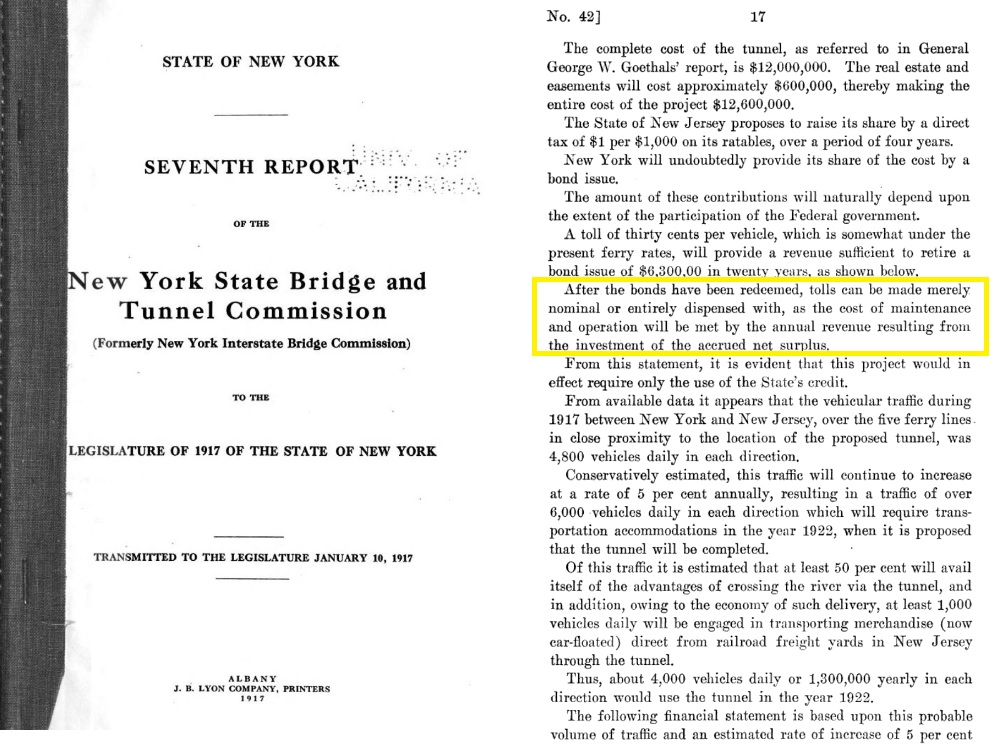 New York State Bridge and Tunnel Commission - 1917 . After the New York State Bridge and Tunnel Commission and the New Jersey Interstate Bridge and Tunnel Commission failed and the Bridge - Tunnel Unification was passed in 1930, the responsibility of affixing the tolls for both the Holland Tunnel as well as the Arthur Kill Bridges (Bayonne, Goethals and Outerbridge Crossing) passed to the Port of New York Authority. Likewise, the Port of New York Authority was authorized to collect those tolls "practical to the costs of construction, maintenance and operation of said bridges and tunnels as a group." 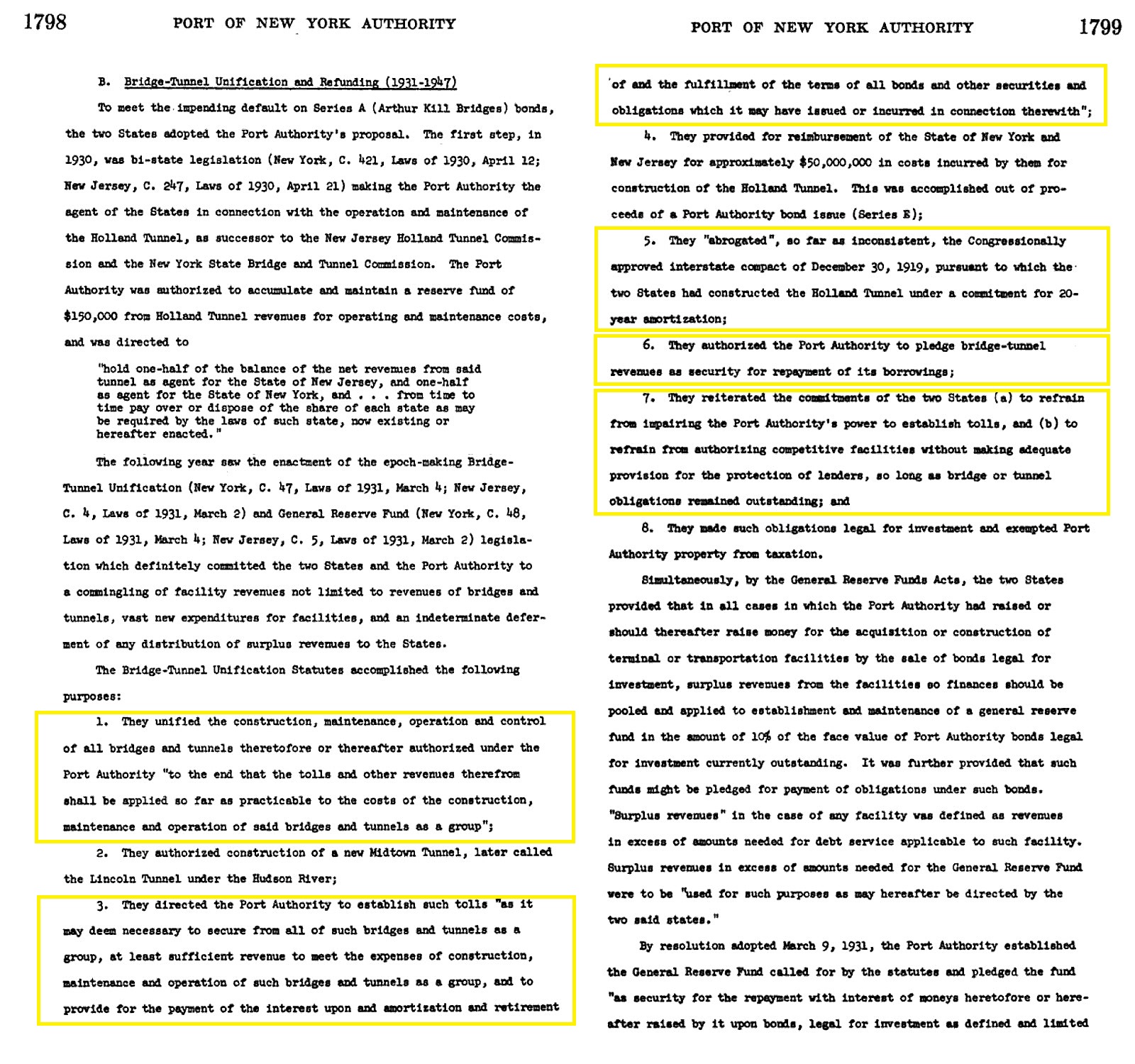 Port of New York Authority, Hearings before Subcommittee #5; 86th Congress, 2nd Session - November 1960 . . 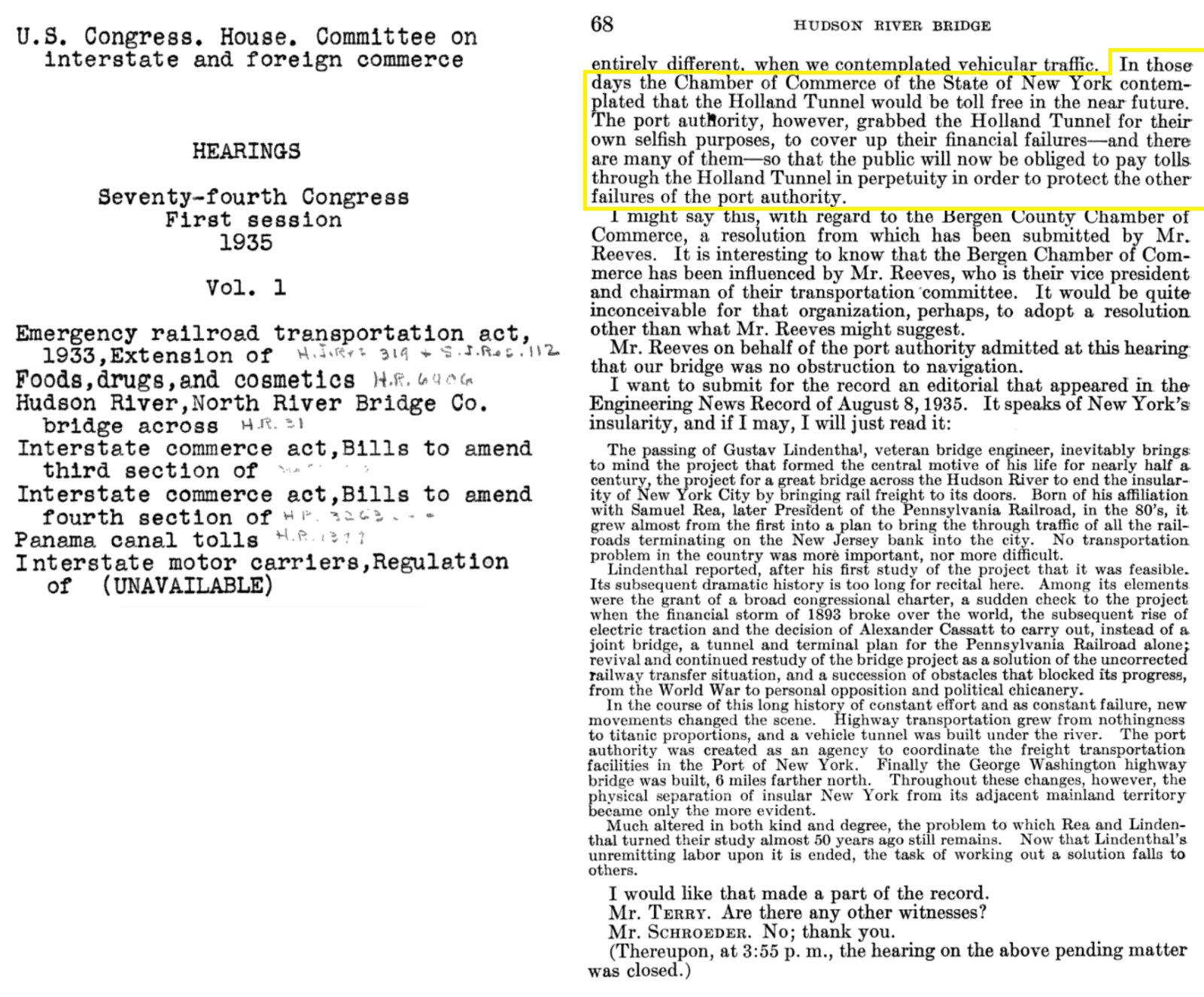 US Congressional House Committee on Interstate Commerce - 1935 .
. 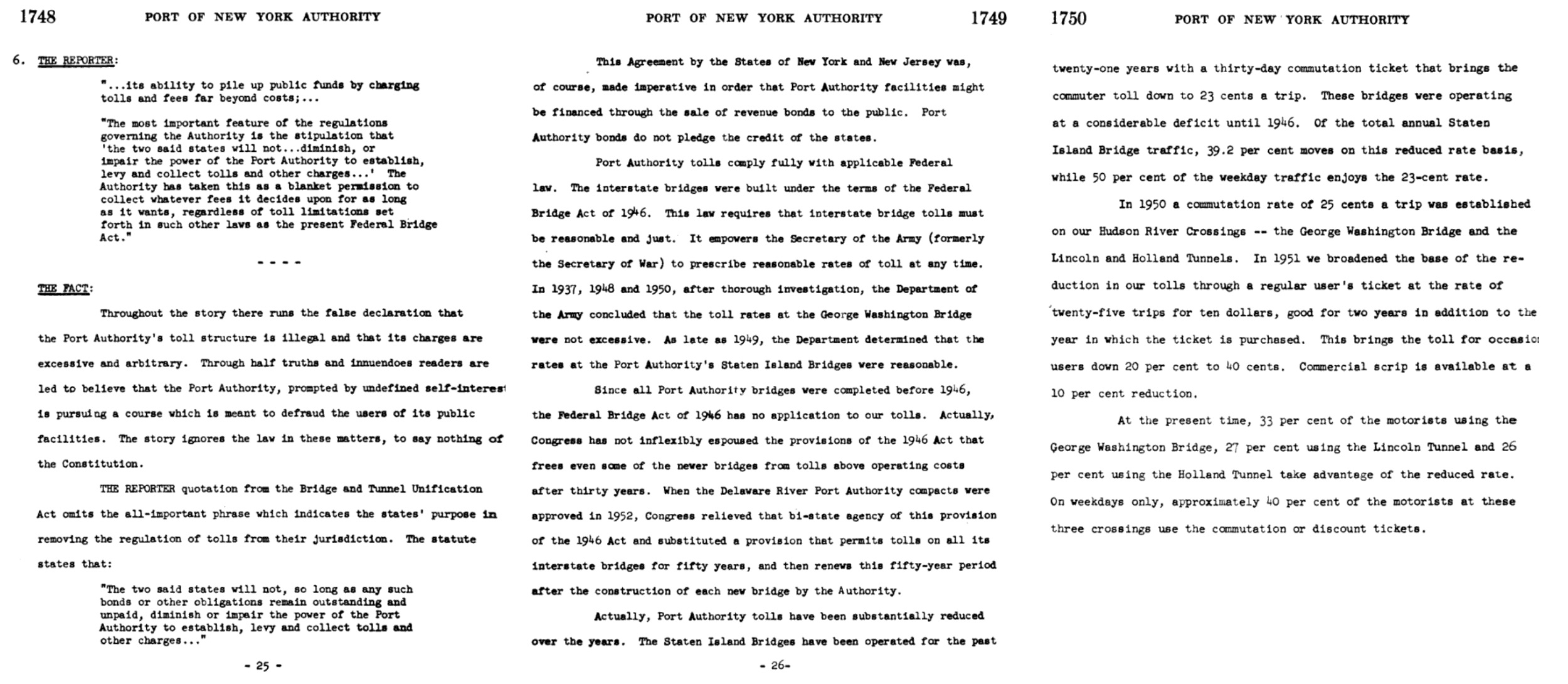 Port of New York Authority, Hearings before Subcommittee #5; 86th Congress, 2nd Session - November 1960 I could go on for quite some time, citing chapter and verse of the regulations and authorizations to collect tolls of the bridges, tunnels and highways in question for the various agencies this website covers; but, I will let you do it if you so wish: Google Books: Port of New York Authority, authorization and empowerment to collect tolls
Google Books: Triborough Bridge Authority, authorization and empowerment to collect tolls I have made my point, and concluded as it can be plainly observed; this urban myth about the Bridges & Tunnels becoming "free." This rumor has existed long before the present day generation picked up on it. In short, ONLY the Holland Tunnel was POTENTIALLY supposed to become toll free. However; as some of us are aware, the New York State Bridge & Tunnel Commission as well as its New Jersey counterpart agency failed; and the Port of New York Authority was tasked with operating the Holland Tunnel under contract, and then finally absorbing the ownership altogether. So, the original intent of the NYSB&TC / NJIB&TC for the tolls to be abrogated, became null and void. To the best of my research; the Port of New York Authority itself made no such suggestion or promises about the abolishment of tolling on the tunnels and bridges under its control; and so the tolls remain to this day and with no false promises of "doing away with the tolls" having been made by the PoNYA or its successor agency, the Port Authority of New York and New Jersey. There are some that contend or argue that Federal Highways (i.e. the Interstate Highway System) are supposed to be toll-free; but this too is a misconception as well. Interstate Highways in the New York / New Jersey Metropolitan area that utilize bridges and tunnels are the following:
This being said, my research has located the following: 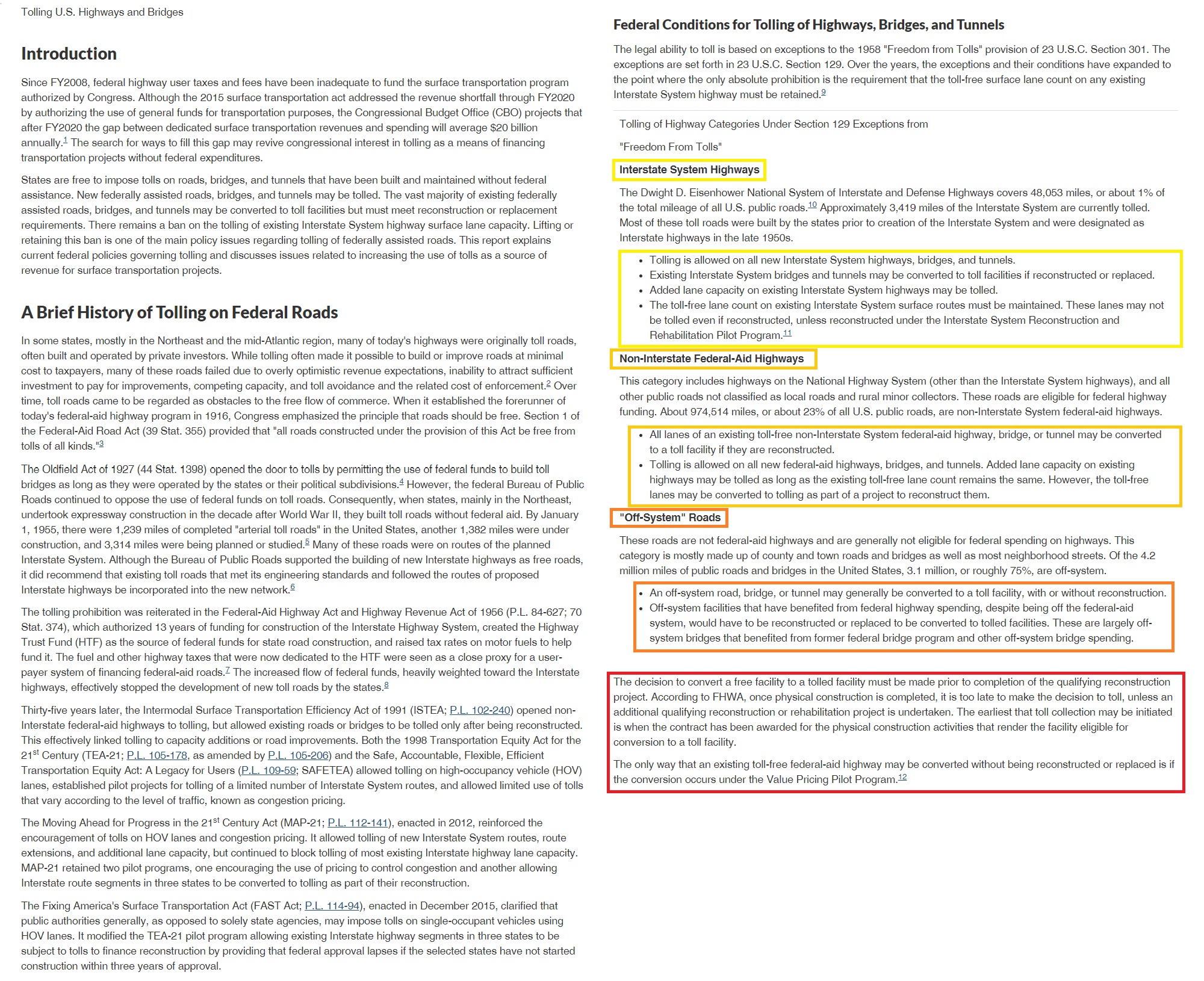 The full content may be read here: https://www.everycrsreport.com/reports/R44910.html#Content So in short, regardless of the origin of this myth, or the belief of its application; the prosaic fact remains that the abrogation of the tolls upon paying off construction of said bridge, tunnel or highway; is a myth. But let us hypothesize they were eliminated. Then what? That bridge, tunnel or highway has been built. But, as with any construction especially of something so complicated: maintenance is required to keep that object in its top form. To name a few: tunnels have water pumps for drainage, and ventilation fans for exchanging the air. Bridges have foundations, suspender cables, anchorages. Both tunnels and bridges have electrical systems and lighting. All these basic things and more, require maintenance. An accident might require replacement of tile or a guard rail. Mechanical equipment wears out. So, it must be repaired or replaced. Older equipment becomes obsolete. Let us look at in smaller, more personal terms: most of you own or rent a domicile. You have it painted or sided every so often. Plumbing requires maintenance, electrical requires maintenance. The shingles / roofing require maintenance. Those of you that purchased a new home, might be able to avoid these expenditures for 10 to 15 years. Those that bought used; usually make improvements. For those of you that rent, your landlord or property manager is responsible for upkeep. Those of you that own a car. You have to change the oil, buy new tires for it every so often, get a tune up, repair parts that wear out. These are all basic maintenance obligations we indebt ourselves to for the convenience of said possessions. But if one does not fix right away, it is known as "deferred maintenance". When one opts to take this route, a small roof leak rots out the boards around the hole, which leads to increased water intrusion, which damages the ceiling, which can cause mold and further rot extends to the walls of the structure. Eventually, the structural integrity is compromised, and either a partial or an entire roof is needed instead of replacing a couple of shingles. If the leak is in a foundation, frost heave further compromises the structural integrity as well as allows greater amounts of water to intrude into the structure. The point I am trying so hard to make; is "deferred maintenance" has never paid off in the long run. One look at the roads and bridges, and the subways during the fiscal crisis of the 1970's and 1980's; should exemplify this quite clearly. We are still paying for that era of "put it off until later". Towards that end of this deferred maintenance, one has to either have to pony up some serious capital to rebuild what you have, or in the cases where it is just not economical feasible, a completely new structure or automobile is needed. Likewise, bridges do in fact wear out. Only so much rust and corrosion can take place before you can no longer weld or bolt patch panels to the structure any more. Ventilation fan motors wear out in tunnels. Electrical and lighting systems become obsolete. Safety systems require upgrading. All of which costs money. Take the Tappan Zee Bridge; it was built during the Korean War and a material shortage, and when built; only had a life expectancy of 50 years. It was reconstructed partially (addition of center lanes and corrosion mitigation in the 1980's). It should have been replaced by 2000. But funding, legal and political wrangling, NIMBYism and the resultant court actions, stop orders / injunctions and environmental reviews; put off construction of the new bridge not beginning until 2012, with opening in 2017. In total, the old bridge was open for 61 years, 9 months, and 21 days. In this case, we were lucky. In other cases we are not: the Mianus River Bridge collapse in Connecticut in 1983; and the I-35W bridge collapse in Minneapolis in 2007 are just two examples of design failures due to age and insufficient maintenance. There are a lot of people that feel costs could be saved by "eliminating upper management" and I somewhat agree here - sometimes management can get a little top heavy. Automated tolling has resulted in the reduction of many lower echelon / lower pay scale employees. But it also bears noting, that it is the professional engineer that goes to a member of upper management, who it turn goes to our elected officials and says; "Hey, the such and crossing in question has outlived its service life 20 years ago. We either have to rebuild it, or replace it or someones gonna get hurt." Whether that engineer is a hired employee of the agency or an outside contractor; they have a salary and need to be paid just the same. Again, replacing these structures is no easy feat with the litigious society that has been allowed to flourish. And it takes 5 to 10 years just to settle the initial injunctions and stop orders and environmental reviews. "I don't that in my back yard. Wah wah wah." But, do any of us really want a rusty, paint flaking, dilapidated structure, potentially collapsing while we cross it? I don't think so. There is yet another downside of doing away with tolls: the financial burden now falls upon everyone in the locality in the form of increased property taxes. Some little old couple, who does not own a car and of whom walks to the neighborhood grocery store and take the bus or subway everywhere. They now faces a higher property tax; because, hey; someone has to pay for the bridge, tunnel or highway maintenance. Funding has to come from somewhere. If not paid by the motorists using the infrastructure; then it will be by the local and / or state residents. And this shifts the burden onto everyones shoulders, including those that do not use the bridges, tunnels and highways. Why should someone in Rochester pay for a bridge repair in Staten Island? Why should someone in the Bronx without a car pay for bridge & tunnel upkeep? In reality, the tolls will never go away. They are necessary towards the continuous funding for the continuous maintenance and repair of the structures, that so many take for granted. With tolling, the subsidization for maintenance and repair falls primarily on those persons using that specific infrastructure - the occasional motorist, the everyday commuter and commercial cargo carrier. Whether they use it once on a vacation trip or everyday to commute, or to deliver goods and household necessities to your local supermarket and store shelves. Tolls are the way to apportion the necessary repair and maintenance funding fairly - by and from the users of that infrastructure. If paying tolls is what it takes to be part of a first world society, where our freedom to travel and commute by personal automobile and purchase sundries and household goods transported by a nationwide distribution network of commercial carriers; then I do not think there are too many other options left to replace the complete and total abolition of tolls. Urban Legend - Mr. Omero C. Catan (Catanzariti)
But, it would be the Lincoln Tunnel that would become the heart of the rift between brothers Omero and Michael. When construction was completed on the tunnels second or northern tube, Omero was serving overseas in the US Army infantry and laying injured in an Army Hospital in England. He asked his brother Michael to "uphold" the family honor and be first through the tube; and on February 1, 1945, he would be. Michael would also be the first:
Note: bridges, tunnels or roads listed above and marked in gold are covered by this website. The brothers, in such contention and competition; hardly spoke in their final years despite retiring to and living only a short distance from each other in Florida. By his own count, Omero stated he accomplished a total of 537 "firsts" when he passed away at 82 years old in 1996. Actually his passing wolud be his 538th "First". He predeceased his brother Michael by 10 years, who passed in 2008 at the age of 95.
How I got started in collecting toll scrip, tokens and ephemera As a child; my parents, my younger sister and I spent a lot of time traveling. Dad was one of those "van guys" and he customized it to make it very convenient to travel. This was before the hey day of the conversion vans. Dad had the van customized with wood cup holders, storage boxes under the seats, privacy curtain behind the driver and passenger seat, one way screen murals for the back windows, and my mother custom sewed pillows and blankets to match the colors of the van: blue & white. He had a CB installed and even though I was young, I learned the 10 code and truckers lingo. From that very early age, we would travel where that weekends fancy would take us. Mostly to railroad venues such as Horseshoe Curve in Altoona and Strasburg Railroad in Pennsylvania; to Steamtown when it was located in Bellows Falls, Vermont. But we also traveled to general interest and tourist locations such as Montauk Point, the Finger Lakes Region of New York; Cooperstown, NY; to family friends in Michigan; and Niagara Falls (on the good side - Canada!) and all around Lake Ontario. Apple picking. Strawberry Picking. Catskill Game Farm. You name it. Once a year, when my sister and I had Easter Break from school; we would embark on a yearly trip down to North Miami Beach to visit my maternal grandparents and paternal aunt and uncle. An inflatable mattress would be shoehorned into the back of the van, along with ice chests of sandwiches and snacks (which would double as tables), insulated jugs of drinks, an ice chest of orange juice, gin and tonic for my parents "relaxer" after the days traveling at the motel. We spent a lot of time traveling and on the road. At every toll bridge or toll barrier for the road we were traveling on; my father would get a receipt and a highway map to give to me to collect. I had a manila envelope filled with ephemera from almost every trip under my seat in the van. As the mileage racked up on that first van; a 1974 Chevrolet Beauville; (over 250,000 when the odometer quit, about 150,000 thousand miles more after that). Original 350 4 barrel engine, original Turbo Hydromatic 350 transmission right until the end! When her transmission started slipping; Dad replaced "Clarabelle" with "Clarabelle II" a '78 Chevy Beauville; and while she was equally up to the task, the memories were in the first van. So many good memories, that we couldn't bear to send her to the scrap heap; so we placed her out to pasture on our upstate property and converted her to a storage shed. I never removed those receipts and maps and they just faded, got brittle, mildewed, turned to dust and made nesting material for field mice. In my late teens, I started collecting US Silver Certificates (blue, brown & yellow seal), United States Notes (red seal); and older Federal Reserve Notes (lime green seal). I acquired most from the cash registers from where I worked, but the rarer issues were purchased from coin shops and currency dealers. A change in employment fields required my now having to cross the toll bridges in New York City, so I kept those receipts. Those that I received as part of my employment of driving a delivery truck, were turned into management for accounting; but the ones for personal use were saved. I mostly used TBTA tokens for my travels to and from Far Rockaway or Lynbrook, Long Island utilizing the Marine Parkway Bridge. My collecting of US Currency progressed in later years into collecting military currencies (military scrip) from around the world as well as US Department of Agriculture Food Coupons (Food Stamps). As a result of my becoming friends with Tom Conklin (the premier USDA Food Coupon collector, historian and author); and in our sharing of our other numismatic pursuits, he passed along his toll scrip collection to me after I had mentioned it to him. But I never forgot those toll receipts, tokens and maps from my childhood and there is regret in not having them now. It's like the old sob story "my mom threw out my comic book collection". Who knew I would be collecting them 40 odd years later? I left the field of numismatics for about 10 years, then started dabbling in collecting Canadian currency. This got its start from an assortment of paper money collected during our visit to the Canadian side of Niagara Falls and driving around Lake Ontario in the 1980's. It was interesting, and so much more attractive and colorful than US Currency; but I was not going to make a name for myself in that field - there were hundreds if not thousands of people with better, larger collections and deeper pockets. During all this time though while browsing on eBay, when I encountered a toll scrip for the Triborough Bridge and Tunnel Authority, the Port Authority of New York or anywhere else in New York State for that matter; I'd still pick it up to add it to my collection. I've always been a collector, but never really a trend setter; always following someone else's lead. I thought, I should start watching eBay in earnest. I've been eBaying for 20 years already, but never specifically looked for toll scrip or toll ephemera. Then, as I was cataloging my toll scrip, I noticed differences in the designs, subtle or glaring; even among the same year issues. And to quote the great Jackie Gleason, "and a-w-a-a-a-y we go!" Here, I realized no one had ever cataloged the various toll issues of the New York Metropolitan region much less published a compendium of the various issues. I knew of one or two token collectors but never the paper issues. So, I started a new chapter in my life. I made acquaintances with George Cuhaj (a very well established token collector and author); who sold me most of his collection of toll scrip; which now augmented my own. I started contacting the various toll bridge & toll highway agencies. Some were extremely helpful and cooperative; others I never heard back from. I have since relocated to Texas, and now as I still collect these issues; some of the more friendly of the eBay sellers (actually only two!) inquired why someone from Texas is so earnestly interested in toll scrip and tokens from New York and New Jersey? This inevitably led to me telling them my history above. I can't imagine there being more a dozen, maybe at best two dozen collectors; of toll scrip for New York and New Jersey, and maybe a hundred for the entire United States. If there are more, they are certainly not well represented in the trade magazines or other numismatic resources. And while collecting something may be good and well enough for some; my desire to was to learn the history of these issues. Without any doubt, this is a niche numismatic collecting and research area if there was ever was one!  Several
people have made significant contributions to this page, whether agency
officials in furnishing information or collectors sharing
images
of their collection.
My grateful appreciation is due to these individuals:
Thanks are also
due in part to the following: Dedication While I have collected these fiscal issues for tolls for decades, I owe a certain amount of credit for the inspiration of this website, to one of my closest friends, who in reality is more like a younger brother; Paul F. Strubeck It was in his endeavor of composing and authoring a completely unrelated magazine article about Long Island Rail Road tractor trailer truck bogies, and the related conclusion of what it cost per truck in tolls at that time. So, he came to me and asked "trying to find NYC bridge toll rates, from 1988." And so here we are.
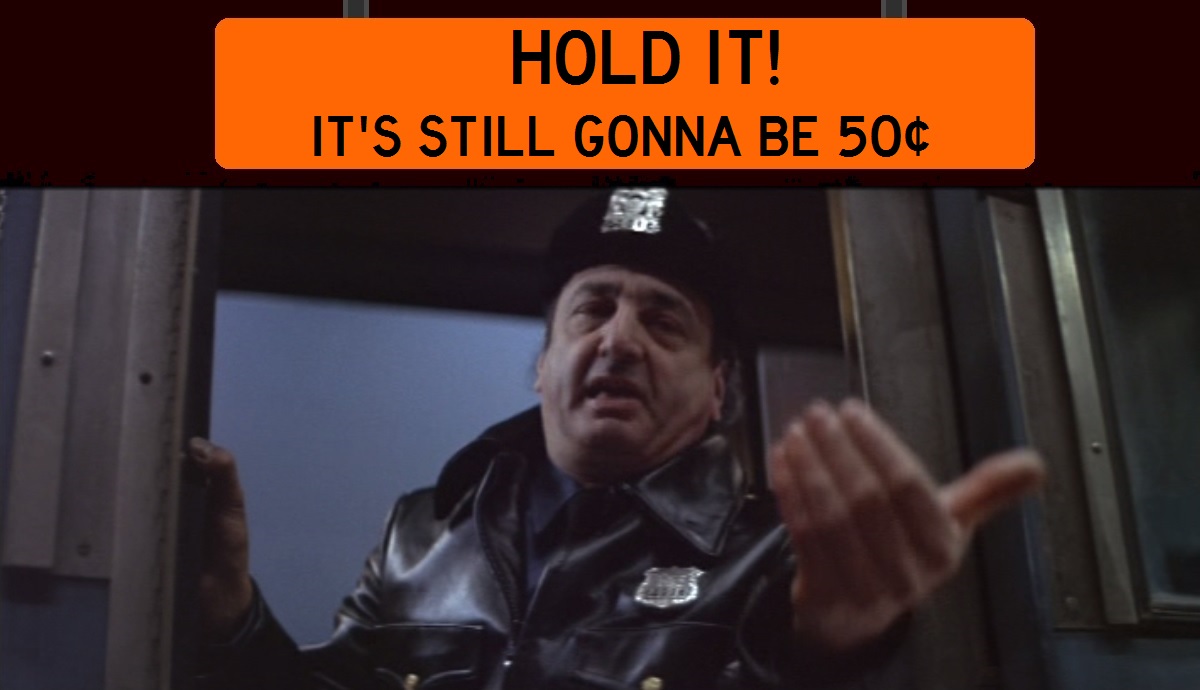 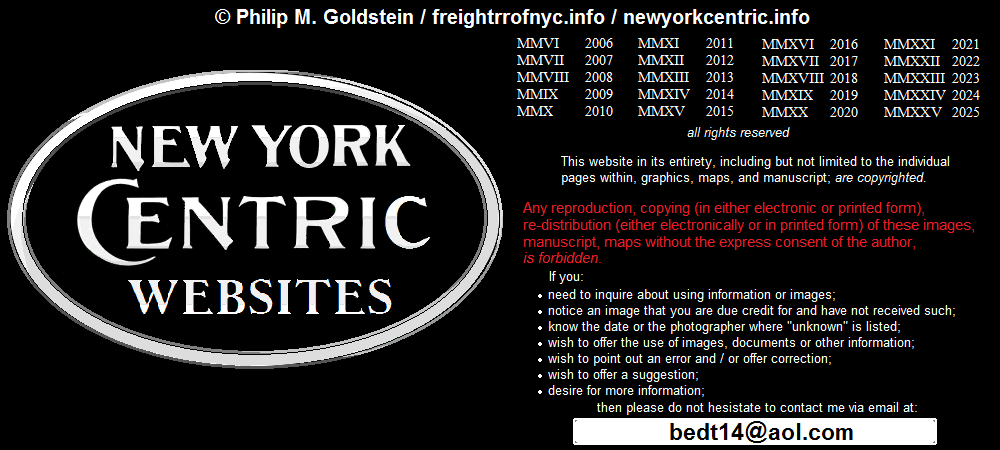 |
||||||||||||||||||||||||||||||||||||||||||||||||||||||||||||||||||||||||||||||||||||||||||||||||||||||||||||||||||||||||||||||||||||||||||||||||||||||||||||||||||||||||||||||||||||||||||||||||||||||||||||||||||||||||||||||||||||||||||||||